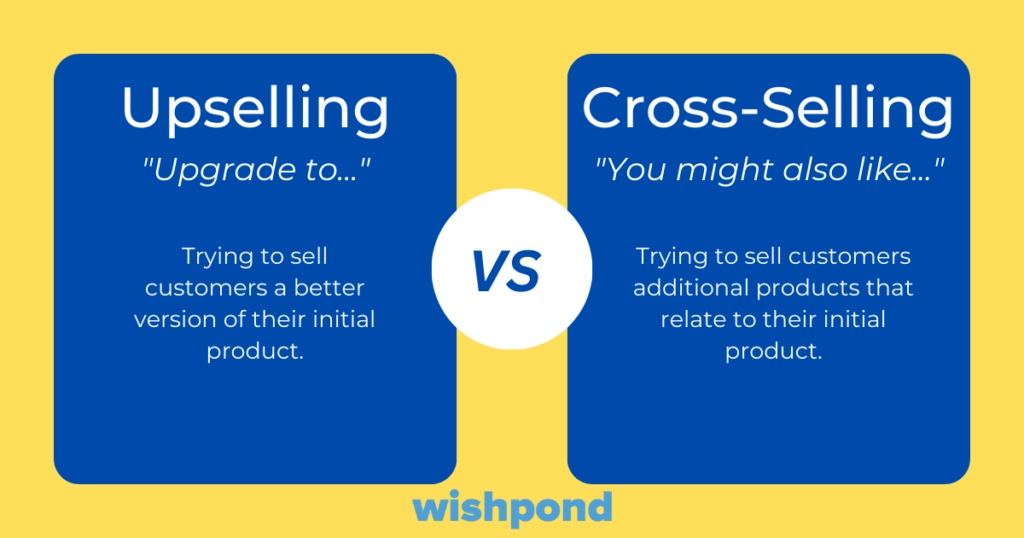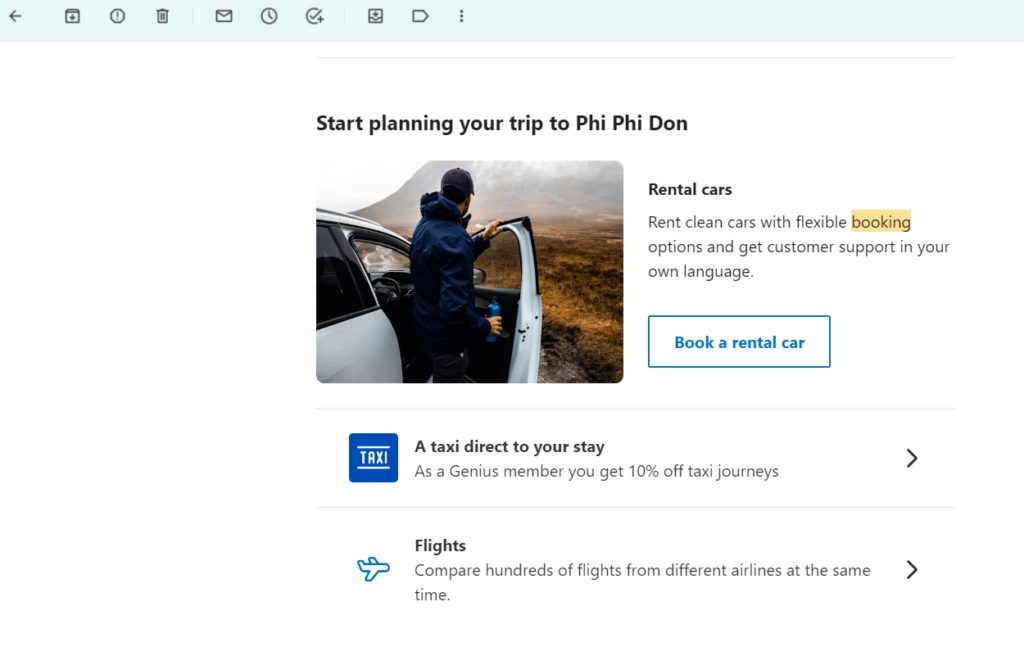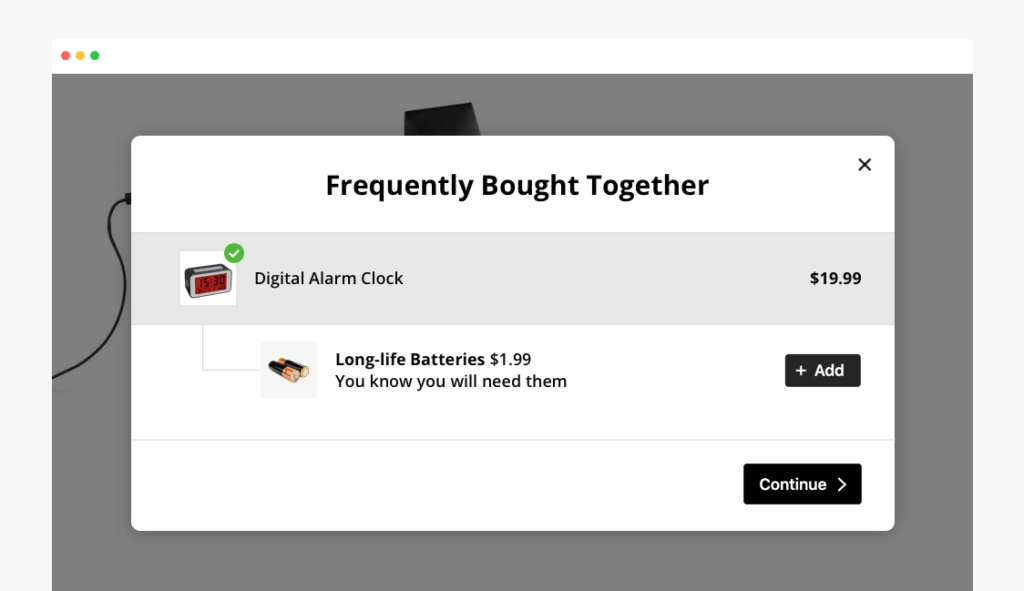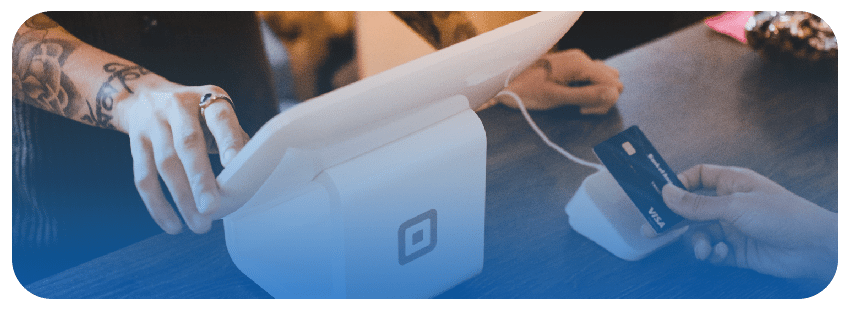If you want to generate more revenue for your business, cross-sell and upsell strategies are two of your best weapons.
72% of salespeople who upsell, and 74% who cross-sell, experience increases in revenue of up to 30%. That’s a lot of extra money your business could be making.
The best part is cross-selling and upselling are pretty easy. With a few simple tactics, you can maximize the value of each existing customer that approaches your business.
In this guide, we’ll tell you exactly how you can do this.
- What is Cross-Selling?
- What is Upselling?
- Cross-Selling vs Upselling
- Cross-Sell and Upsell Examples
- Why are Upselling and Cross-Selling Important?
- How to Cross-Sell and Upsell
- Cross-Sell and Upsell Strategies Your Small Business Can Use
What is Cross-Selling?
Cross-selling is encouraging your existing customers to purchase additional products related to their primary product.
If your business offers a range of products that relate to each other in some way, then you can use cross-selling to provide customers with additional purchasing opportunities.
For example, your store might sell puffer jackets. When a customer purchases (or is about to purchase) a jacket, you can cross-sell your special puffer jacket detergent to them.
Cross-selling works best when the additional products you sell are of a lower value than the initial product.
What is Upselling?
Upselling is encouraging your existing customer to increase the value of their order by opting for a more expensive or a more premium product selection.
With upselling, you’re not trying to sell a different kind of product to the customer. Instead, you’re trying to sell them a better, more expensive version of the product they are interested in. This will help you generate a larger, more profitable sale.
Let’s go back to the down puffer jacket example. A customer visits your store and is interested in your standard puffer jacket. Upselling is convincing this customer to purchase your premium jacket because its features are better.
Cross-Selling vs. Upselling
While cross-selling is all about selling laterally (i.e., expanding the buyer’s product opportunities to other products), upselling is a vertical approach that aims to upgrade the customer’s initial product.
Both cross-sell and upsell sales strategies are important for generating more value from your customers and maximizing your sales opportunities. Both strategies can be used together to increase your customer’s average order value and generate more revenue for your business.

Cross-Sell and Upsell Examples
One of the best cross-sell and upsell examples comes from Amazon.
When you look at a product, you’ll immediately see a strip of related products underneath the initial product. For example, if you look at a bicycle, you get recommended products like cycling shorts:

There are also options to add accessories:

Add the bike to my cart, and even more cross-selling options appear:

Clearly, Amazon does everything it can to maximize the value of your cart. All recommended products are related to the initial purchase, so they’re personalized and add value to the user – which isn’t annoying. In fact, it’s tempting.
Cross-selling examples like this work particularly well for eCommerce stores.
Now, let’s say I went into my local bike shop and asked about this same brand of bicycle. The bike store salesperson could point out the potential flaws in this bicycle model and then offer to show me an even better (more expensive) bicycle that better matches my needs. This is upselling.
I choose the bicycle and get to the counter to pay. Before making the payment, the salesperson asks if I’d like to add a helmet and saddle bag as part of a discounted package. This is another example of cross-selling.
In all of these examples, the sales strategies have added value to me as a consumer and helped open my eyes to further opportunities I didn’t know existed. This is what makes them effective.
Why are Upselling and Cross-Selling Important?
There are two main reasons why your business should cross-sell and upsell.
First of all, it helps you generate more revenue. Cross-selling and upselling maximize the value of each customer and ensure you target the customer with every relevant sales and revenue opportunity.
This means more money from each customer and more profit for your business.
The other major benefit of cross-selling and upselling is that it enhances the customer experience.
Cross-selling opportunities aren’t only cheeky sales tactics. They can help you provide more personalized solutions to your customers, which helps your customers feel like they get better value from your business.
This is because successful cross-selling and upselling are not just about making more sales. Instead, they’re about making sure your customers can truly make the most of your business. Do it right, and customers won’t feel like they’ve been cheated. Instead, they’ll walk away from their purchase feeling like they gained extra value.
The best part of all this is that upselling and cross-selling can actually be really easy to do. In fact, you can automate most of it.
More money for your business, better customer satisfaction, and barely any effort – sounds too good to be true? It’s not.
We’ll uncover some of the best cross-sell and upsell strategies you can use.
How to Cross-Sell and Upsell
There are various tactics you can use for upselling and cross-selling. No matter what tactics you use, though, it’s important that you first cover a few necessary bases.
Here are some of the most important tips and steps to get right before you can implement cross-sell and upsell strategies.
1. Know Your Products
Any successful cross-selling or upselling strategy starts with having a deep understanding of your products. Without this, you won’t know what relevant upsell and cross-sell opportunities you can capitalize on.
Understand all possible use cases of your products, and know about all cross-sell or upsell opportunities that might exist for each use case.
2. Know Your Customers
Upselling and cross-selling will be extremely difficult if you don’t have a deep understanding of your customers. This is because each sales strategy should be focused on offering a personalized customer experience.
Understand your target audience and understand each specific customer’s position when you try to upsell to them. This includes understanding what might motivate the customer, what their interests are, or what kind of additional value they might be interested in.
The better you understand your customers, the better you’ll be able to target them with personalized selling opportunities.
This increases the chances of the customer taking the bait.
3. Sell Ideas, Not Products
You may be trying to sell extra products and services to your customers, but you don’t want to come across as being a pushy salesperson. Never make it feel like you’re trying to get your customers to spend more money.
Instead, try to tell a story and sell the idea or experience. This comes down to highlighting the value and what the customer can achieve from your product.
Don’t try to sell the customer a product by just offering them a product. Instead, offer them the idea of what the product can help them achieve. Highlight the benefits of the product, display its value, and outline why it would be a smart choice for the customer to choose.
Then, the customer will make the decision to spend more money (instead of it being something you pushed on them).
4. Refine and Minimize Selling Opportunities
You might have a whole load of cross-sell and upsell opportunities available. Don’t offer them all – this will look like you’re trying to sell too hard to the customer.
Instead, narrow down your options to about three solutions, and try to pitch these to your customer. Of course, you’ll want to personalize each option to the customer so that it’s most relevant to them.
Offering fewer options will look more personal and more thoughtful, which should help you to boost the chances of a sale. Push too hard, and you won’t attract the customer’s attention.
5. Use Technology
The right tech tools can help you cross-sell and upsell a lot more efficiently.
For example, you could use tools like email automation or popups to help you offer relevant selling opportunities. These tools can all be automated, saving you valuable time and effort. This also ensures you target every customer and every possible cross-sell and upsell opportunity that exists.
6. Check in With Your Customers
Cross-selling and upselling don’t only happen during the initial purchase phase. You can cross-sell and upsell to your customers later on in their journey. To do this, it’s important that you reach out to customers and stay in touch with them.
For example, you might want to reach out to a customer a month or so after they made a purchase. Ask them about how their experience is going with your product. This might open up new opportunities to sell them additional products or services.
At the same time, you might offer a recurring product or service or have customers that visit you for regular services (such as a massage therapist). In this case, reach out to your customers after each session to see how they’re feeling and try to discover if there are additional problems you could help them solve.
For example, a massage therapist could also sell essential oils or lotions to their customers to take home. Asking for customer feedback can help you gain these valuable cross-selling insights.
7. Consider the Entire Customer Journey
When you cross-sell and upsell, don’t just think about making a single sale. Rather think about the entire customer journey and look at it long-term.
Your goal should be to retain customers and gain as much long-term value from them as possible. You also want customers to have a positive experience with your business.
This means that just because cross-sell and upsell opportunities exist, it doesn’t mean you need to always push them. Only try to sell to a customer when it actually makes sense for their situation. This can help you generate a more positive experience from the customer and help them come back for more.
If you sell the wrong things to customers, you might end up scaring them away from your business forever. So, be strategic.
Your goal with upselling and cross-selling should be to maximize the value of each customer. This includes thinking long-term and considering the entire customer journey. Get this right, and you might discover new upsell opportunities later down the line.
Cross-Sell and Upsell Strategies Your Business Can Use
Now that we’ve covered the basics of cross-selling and upselling, it’s time to start implementing these tactics into your business.
Here are some of the best cross-sell and upsell strategies you can use to do this.
1. Email Marketing
Email marketing is one of the best ways to upsell or cross-sell to your customers. You can do this as soon as a customer makes a purchase, or you can do it further into the customer journey.
The best tactic is to use email automation to send automated emails based on certain purchases or actions.
For example, if a customer purchases a product on your website, you can send them an automated email promoting related products (cross-sell). You could also send an automated email to a customer offering them a limited-time upgrade opportunity (upsell).

To do this, you’ll need to use an email marketing platform like Wishpond that lets you select custom actions for your customers and leads, and segment different people into different lists to send relevant content.
You could also create an email list that automatically adds customers of a certain product or service to a list. Then, send emails to this list at a later stage with any relevant offers, products, or services.
This could apply to any business. For example, you could be an HVAC contractor, and you have an email list of all the people who you installed an air conditioning unit for. You could send an annual email to this list offering a discounted service for air conditioning repairs and checkups or additional product installations. This can be an effective way to generate repeat business from these customers.
An example of this is Booking.com. When you make a booking through their site, they send you an automated email with discounts on related attractions, activities, flights, and car rentals in the area you’re visiting. This is a smart way to generate cross-sell sales.

2. Popups
Strategic popups are one of the best ways to upsell or cross-sell to your customers.
When a customer is on a product or booking page on your website, you can trigger popups to target them with relevant offers at a crucial time in their buying journey.
For example, someone might add a pair of shoes to their cart. Then you can trigger a popup that displays socks or special sneaker polish to use with their purchase. You could also add popup banners that appear at the top, bottom, or sides of the screen. This works similarly to the Amazon example outlined above.
You could also use popups for upsells. For example, a user might add a 250g bag of coffee to their cart. When they do, a popup triggers, offering them a 500g bag of the same coffee, showing the customer that they save $2 by placing a larger order. This is an easy example of upselling.
The great thing about using popups is that you can just set them and forget them. This way, you make sure a relevant upsell or cross-sell offer displays to each customer on your site without you having to reach out to these customers personally.
This is an easy way to display more product offers without any extra effort.
Here’s a great example of how you can increase your order value with a popup.

3. Discounts
If you want to encourage more sales, few tactics are as effective as offering a discount.
Discounts are one of the best ways to encourage upselling or cross-selling. You can use them in any other kinds of strategies here, like emails or popups.
The best tactic is to entice customers with a relevant upsell or cross-sell offer and run a small discount or promotion. You already know that this customer has shown an interest in your product and business, so a discount could be just the push they need to increase their order value.
If a customer already makes a purchase, you can send them a targeted email offering discounts on related products. If a customer is yet to make a purchase, you might want to offer a discount on an upsell before they buy.
You could also offer a special promotion, such as free shipping. This is a tactic that many online stores use to generate a higher average order value.
For example, you could offer free shipping for orders above $100. If a customer purchases a $90 item, there’s a good chance they’ll add another smaller item to their cart to get free shipping.

4. Limited-Time Offers
On the topic of running discounts and special promotions, creating a sense of urgency will help to make these promotions more effective. Offering a limited-time offer is a great way to do this.
Whether it’s an email or popup promotion, giving the promotion a time limit will give your customers more reason to make a purchase quickly. Without this, they might consider the offer but never get around to going through with it.

5. Product Bundles
Offering special product bundles is another great way to generate more sales. This is strictly a cross-selling tactic to help you increase the average order value.
Instead of just offering a string of related products, you can group together certain products and services and add them as part of a bundle.
Let’s go back to the bicycle example for this. You could sell a bicycle for $200 and a helmet for $50. Now you can create a product bundle that includes both items for $220. Or sell it for $250 and add a free bicycle service.
Customers will think they get better value with the bundle (which they do), which will make it more enticing. This will also help you generate more revenue from each customer.

6. Partner With Other Businesses
Coming up with compelling cross-sell offers can be a lot more effective if you include other businesses in these offers.
To do this, you’ll want to find businesses that complement your offering but don’t compete with it. You also need to make sure you have the same target audience so that whatever offers you have appeal to the same people.
A good example of this would be a tour operator. Let’s say you sell travel experiences to a certain attraction or destination. You can partner up with other providers, like restaurants, hotels, or spas, to add additional products your customers might be interested in.
When doing this, you’ll need to establish an agreement with each business where you share a portion of the sales. This should be a win-win situation for everyone involved, as each business can promote each other to freely attract more customers.
The Bottom Line
It really doesn’t matter what you sell or how you sell it, cross-sell and upsell opportunities are always an excellent way to maximize your revenue.
You can use a variety of tactics listed above. Just make sure that you understand your customers and only offer relevant, valuable solutions to them. As long as you offer value to your customers, your cross-sell and upsell efforts will pay off.
To pull this off, you’ll also need to use the right software tools. With a solution like Propel IQ, you can access email and marketing automation, build a website with popups, send automated SMS campaigns, run discounts and special promotions, and more. Basically, everything you need to increase your revenue opportunities. See how your business can use it if you want to start generating better sales.
Related Content
- How to Use Social Media for eCommerce
- Everything You Need to Know About eCommerce Marketing
- 21 Shopify Marketing Strategies to Double Your Sales
- How to Reduce Cart Abandonment: 12 Strategies for Shopify

